Stewart J. Calculus
Подождите немного. Документ загружается.

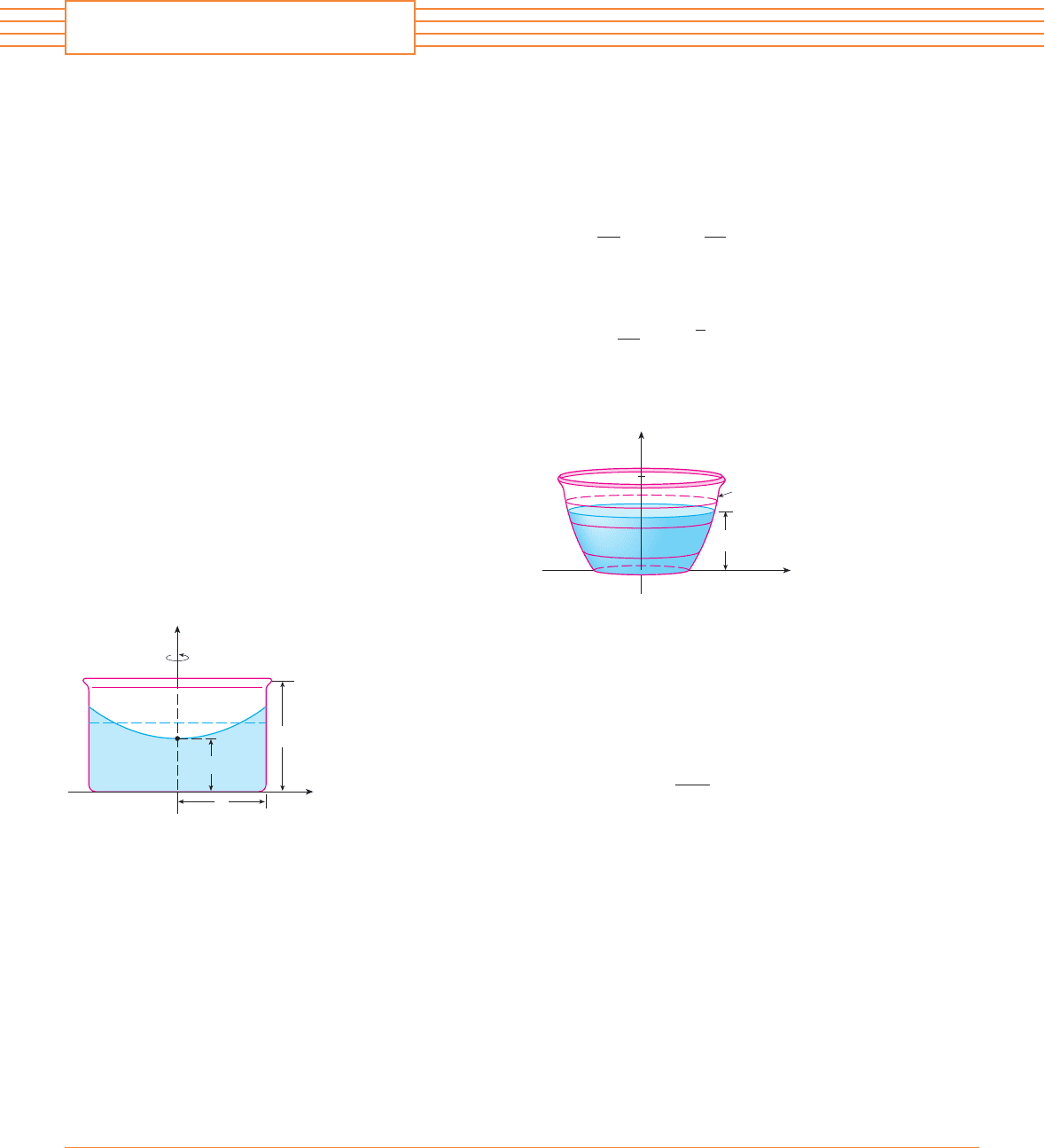
382
11. A clepsydra, or water clock, is a glass container with a small hole in the bottom through
which water can flow. The “clock” is calibrated for measuring time by placing markings on
the container corresponding to water levels at equally spaced times. Let be continu-
ous on the interval and assume that the container is formed by rotating the graph of
about the -axis. Let denote the volume of water and the height of the water level at time .
(a) Determine as a function of .
(b) Show that
(c) Suppose that is the area of the hole in the bottom of the container. It follows from
Torricelli’s Law that the rate of change of the volume of the water is given by
where is a negative constant. Determine a formula for the function such that is a
constant . What is the advantage in having ?
12. A cylindrical container of radius and height is partially filled with a liquid whose volume
is . If the container is rotated about its axis of symmetry with constant angular speed , then
the container will induce a rotational motion in the liquid around the same axis. Eventually,
the liquid will be rotating at the same angular speed as the container. The surface of the liquid
will be convex, as indicated in the figure, because the centrifugal force on the liquid particles
increases with the distance from the axis of the container. It can be shown that the surface of
the liquid is a paraboloid of revolution generated by rotating the parabola
about the -axis, where is the acceleration due to gravity.
(a) Determine as a function of .
(b) At what angular speed will the surface of the liquid touch the bottom? At what speed will
it spill over the top?
(c) Suppose the radius of the container is 2 ft, the height is 7 ft, and the container and liquid
are rotating at the same constant angular speed. At the central axis the surface of the liquid
is 5 ft below the top of the tank, and 1 ft out from the central axis the surface is 4 ft below
the top of the tank.
(i) Determine the angular speed of the container and the volume of the fluid.
(ii) How far below the top of the tank is the liquid at the wall of the container?
13. Suppose the graph of a cubic polynomial intersects the parabola when , ,
and , where . If the two regions between the curves have the same area, how
is related to ?ab
0
a
bx 苷 b
x 苷 ax 苷 0y 苷 x
2
h
ty
y 苷 h
2
x
2
2t
V
Lr
x
y
x=f(y)
h
b
dh兾dt 苷 CC
dh兾dtfk
dV
dt
苷 kA
s
h
A
dV
dt
苷
关 f 共h兲兴
2
dh
dt
hV
thVy
f关0, b兴
x 苷 f 共y兲
PROBLEMS PLUS
FIGURE FOR PROBLEM 12
x
y
h
L
r
v

383
14. Suppose we are planning to make a taco from a round tortilla with diameter 8 inches by bend-
ing the tortilla so that it is shaped as if it is partially wrapped around a circular cylinder. We
will fill the tortilla to the edge (but no more) with meat, cheese, and other ingredients. Our
problem is to decide how to curve the tortilla in order to maximize the volume of food it can
hold.
(a) We start by placing a circular cylinder of radius along a diameter of the tortilla and
folding the tortilla around the cylinder. Let represent the distance from the center of the
tortilla to a point on the diameter (see the figure). Show that the cross-sectional area of
the filled taco in the plane through perpendicular to the axis of the cylinder is
and write an expression for the volume of the filled taco.
(b) Determine (approximately) the value of that maximizes the volume of the taco. (Use a
graphical approach with your CAS.)
15. If the tangent at a point on the curve intersects the curve again at , let be the
area of the region bounded by the curve and the line segment . Let be the area of the
region defined in the same way starting with instead of . What is the relationship between
and ?BA
PQ
BPQ
AQy 苷 x
3
P
P
x
r
A共x兲 苷 r
s
16 x
2
1
2
r
2
sin
冉
2
r
s
16 x
2
冊
P
P
x
r
CAS
PROBLEMS PLUS
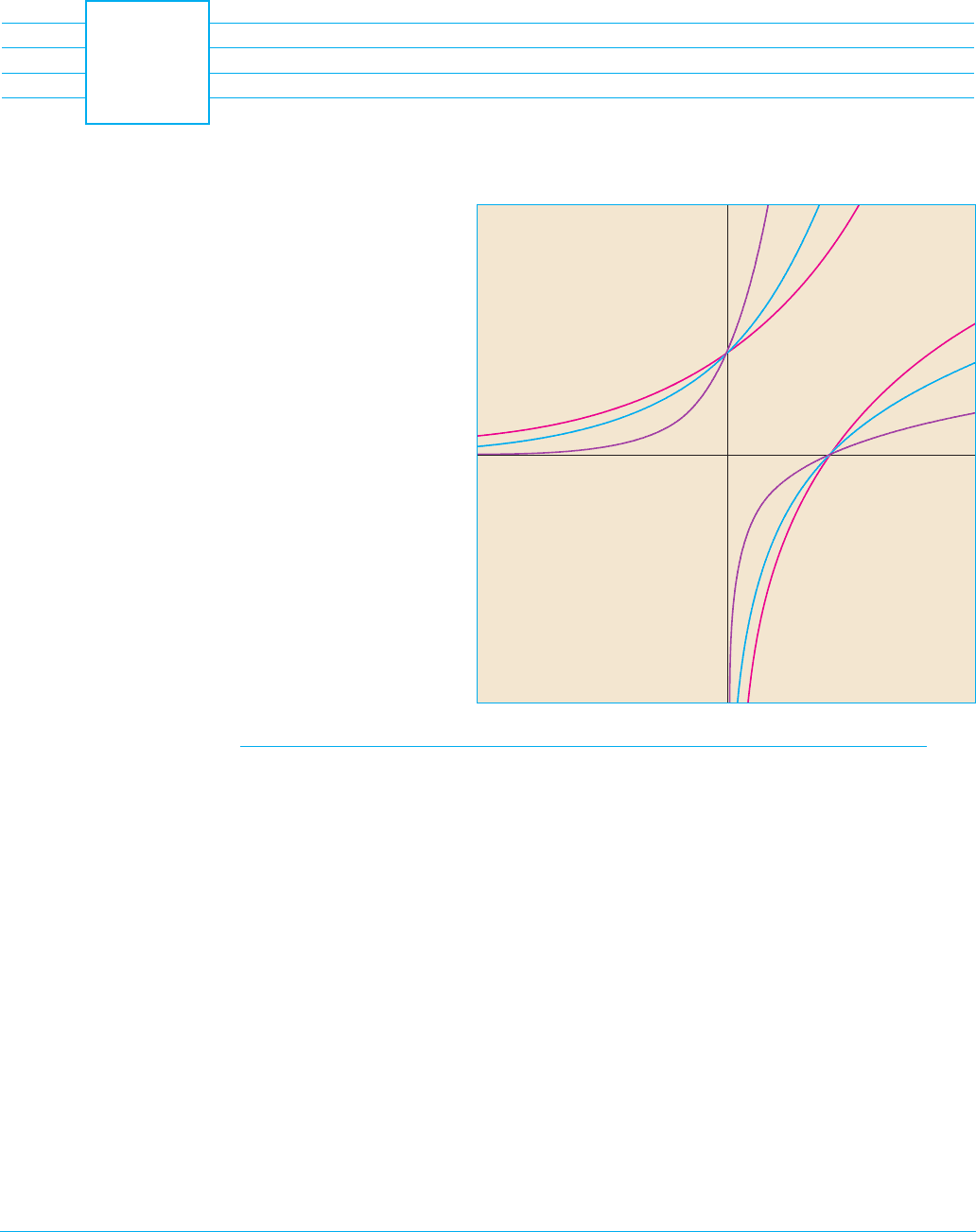
384
The common theme that links the functions of this chapter is that they occur as pairs of
inverse functions. In particular, two of the most important functions that occur in
mathematics and its applications are the exponential function and its inverse
function, the logarithmic function . In this chapter we investigate their
properties, compute their derivatives, and use them to describe exponential growth and
decay in biology, physics, chemistry, and other sciences. We also study the inverses of
trigonometric and hyperbolic functions. Finally, we look at a method (l’Hospital’s Rule)
for computing difficult limits and apply it to sketching curves.
There are two possible ways of defining the exponential and logarithmic functions
and developing their properties and derivatives. One is to start with the exponential
function (defined as in algebra or precalculus courses) and then define the logarithm as
its inverse. That is the approach taken in Sections 7.2, 7.3, and 7.4 and is probably the
most intuitive method. The other way is to start by defining the logarithm as an integral
and then define the exponential function as its inverse. This approach is followed in
Sections 7.2*, 7.3*, and 7.4* and, although it is less intuitive, many instructors prefer it
because it is more rigorous and the properties follow more easily. You need only read
one of these two approaches (whichever your instructor recommends).
t!x" ! log
a
x
f !x" ! a
x
The exponential and
logarithmic functions are
inverse functions of each other.
INVERSE FUNCTIONS:
EXPONENTIAL,
LOGARITHMIC, AND
INVERSE TRIGONOMETRIC
FUNCTIONS
7
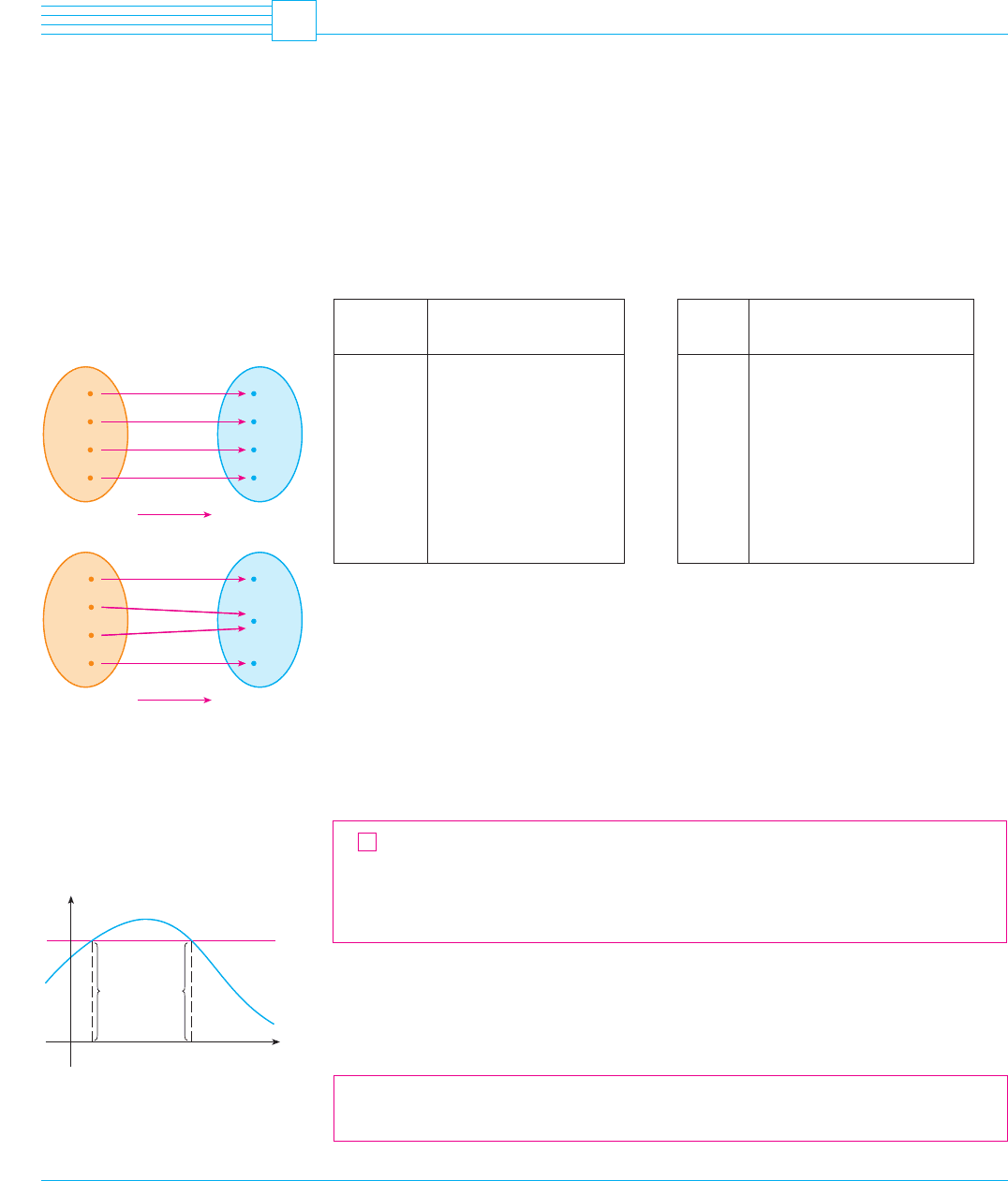
INVERSE FUNCTIONS
Table 1 gives data from an experiment in which a bacteria culture started with 100 bacte-
ria in a limited nutrient medium; the size of the bacteria population was recorded at hourly
intervals. The number of bacteria N is a function of the time t: .
Suppose, however, that the biologist changes her point of view and becomes interested
in the time required for the population to reach various levels. In other words, she is think-
ing of t as a function of N. This function is called the inverse function of f, denoted by ,
and read “f inverse.” Thus is the time required for the population level to reach
N. The values of can be found by reading Table 1 from right to left or by consulting
Table 2. For instance, because
Not all functions possess inverses. Let’s compare the functions and whose arrow
diagrams are shown in Figure 1. Note that never takes on the same value twice (any two
inputs in have different outputs), whereas does take on the same value twice (both 2
and 3 have the same output, 4). In symbols,
but
Functions that share this property with are called one-to-one functions.
DEFINITION A function is called a one-to-one function if it never takes on
the same value twice; that is,
If a horizontal line intersects the graph of in more than one point, then we see from
Figure 2 that there are numbers and such that . This means that is not
one-to-one. Therefore we have the following geometric method for determining whether a
function is one-to-one.
HORIZONTAL LINE TEST A function is one-to-one if and only if no horizontal line
intersects its graph more than once.
ff !x
1
" ! f !x
2
"x
2
x
1
f
whenever x
1
" x
2
f !x
1
" " f !x
2
"
f
1
f
whenever x
1
" x
2
f !x
1
" " f !x
2
"
t!2" ! t!3"
tA
f
tf
f !6" ! 550.f
!1
!550" ! 6
f
!1
t ! f
!1
!N"
f
!1
N ! f !t"
7.1
385
TA B L E 2 t as a function of N
N ! time to reach N bacteria
100 0
168 1
259 2
358 3
445 4
509 5
550 6
573 7
586 8
t ! f
!1
!N"
TA B L E 1 N as a function of t
t
(hours) ! population at time t
0 100
1 168
2 259
3 358
4 445
5 509
6 550
7 573
8 586
N ! f !t"
4
3
2
1
10
4
2
A B
g
F I G U R E 1
4
3
2
1
10
7
4
2
A B
f
f is one-to-one; g is not
0
‡fl
y=ƒ
F I G U R E 2
This function is not one-to-one
because f(⁄)=f(¤).
y
x
⁄
¤
N In the language of inputs and outputs, this
definition says that is one-to-one if each out-
put corresponds to only one input.
f
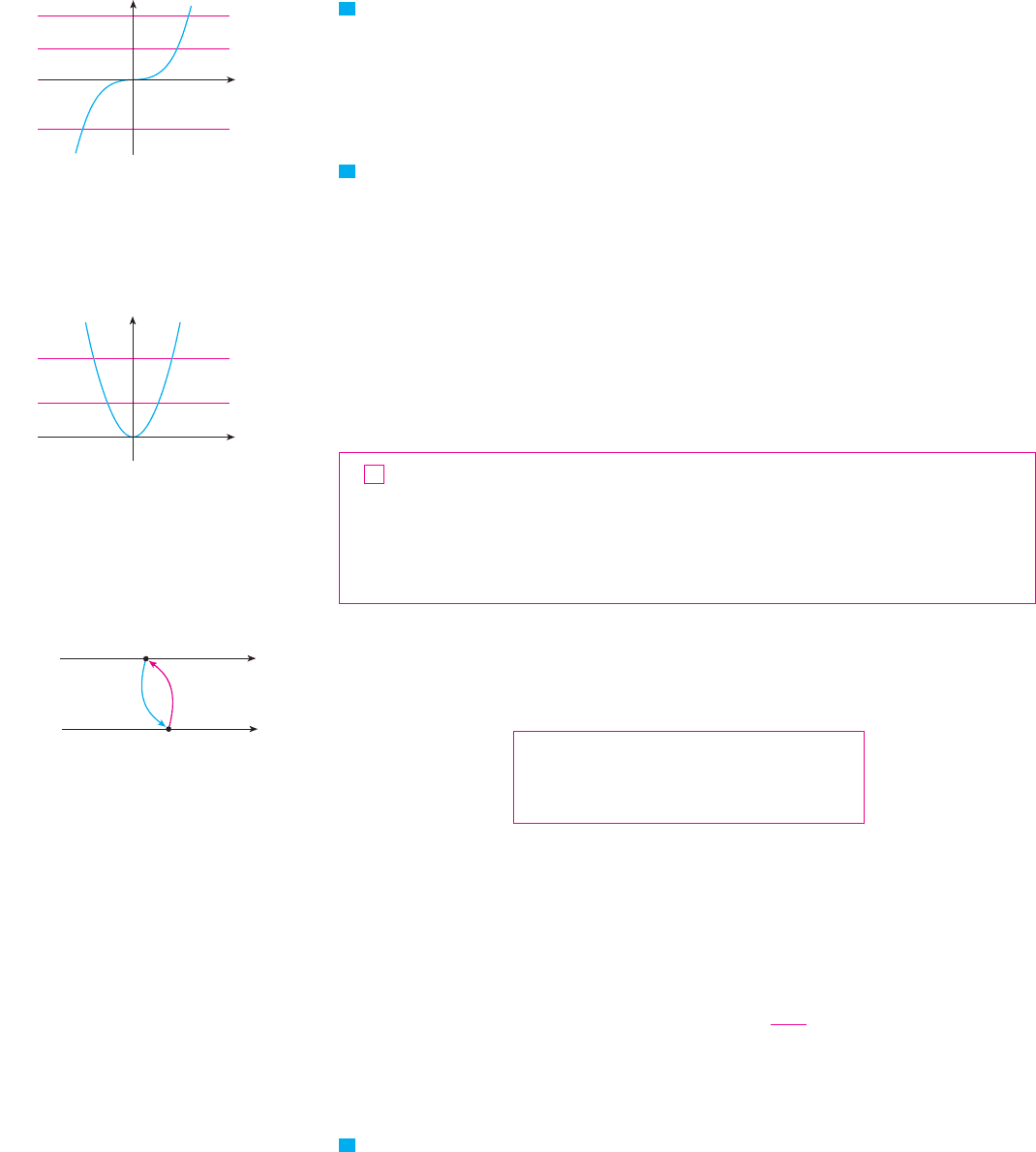
EXAMPLE 1 Is the function one-to-one?
SOLUTION 1 If , then (two different numbers can’t have the same cube).
Therefore, by Definition 1, is one-to-one.
SOLUTION 2 From Figure 3 we see that no horizontal line intersects the graph of
more than once. Therefore, by the Horizontal Line Test, is one-to-one. M
EXAMPLE 2 Is the function one-to-one?
SOLUTION 1 This function is not one-to-one because, for instance,
and so 1 and have the same output.
SOLUTION 2 From Figure 4 we see that there are horizontal lines that intersect the graph of
more than once. Therefore, by the Horizontal Line Test, is not one-to-one. M
One-to-one functions are important because they are precisely the functions that pos-
sess inverse functions according to the following definition.
DEFINITION Let be a one-to-one function with domain and range . Then
its inverse function has domain and range and is defined by
for any in .
This definition says that if maps into , then maps back into . (If were not
one-to-one, then would not be uniquely defined.) The arrow diagram in Figure 5 indi-
cates that reverses the effect of . Note that
For example, the inverse function of is because if , then
|
CAUTION
Do not mistake the in for an exponent. Thus
The reciprocal could, however, be written as .
EXAMPLE 3 If , , and , find
and .f
!1
!!10"
f
!1
!5",f
!1
!7",f !8" ! !10f !3" ! 7f !1" ! 5
V
# f !x"$
!1
1%f !x"
1
f !x"
does not meanf
!1
!x"
f
!1
!1
f
!1
!y" ! f
!1
!x
3
" ! !x
3
"
1%3
! x
y ! x
3
f
!1
!x" ! x
1%3
f !x" ! x
3
range of f
!1
! domain of f
domain of f
!1
! range of f
ff
!1
f
!1
fxyf
!1
yxf
By
f !x" ! y&?f
!1
!y" ! x
ABf
!1
BAf
2
tt
!1
t!1" ! 1 ! t!!1"
t!x" ! x
2
V
f
f !x" ! x
3
f !x" ! x
3
x
3
1
" x
3
2
x
1
" x
2
f !x" ! x
3
V
386
|| ||
CHAPTER 7 INVERSE FUNCTIONS
F I G U R E 3
ƒ=˛ is one-to-one.
0
y=˛
y
x
x
y
A
B
f –!
f
F I G U R E 5
F I G U R E 4
©
=≈ is not one-to-one.
0
y=≈
x
y
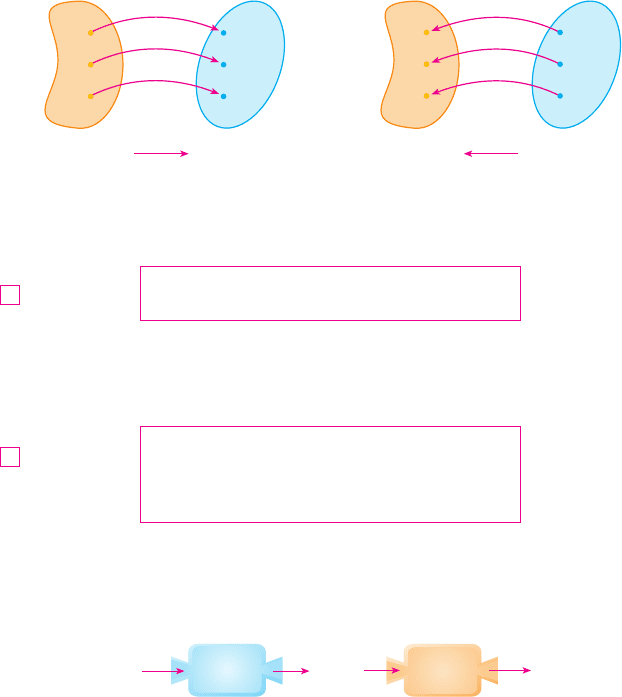
SOLUTION
From the definition of we have
The diagram in Figure 6 makes it clear how reverses the effect of in this case.
M
The letter is traditionally used as the independent variable, so when we concentrate
on rather than on , we usually reverse the roles of and in Definition 2 and write
By substituting for in Definition 2 and substituting for in (3), we get the following
cancellation equations:
The first cancellation equation says that if we start with , apply , and then apply we
arrive back at , where we started (see the machine diagram in Figure 7). Thus undoes
what does. The second equation says that undoes what does.
For example, if , then and so the cancellation equations become
These equations simply say that the cube function and the cube root function cancel each
other when applied in succession.
Now let’s see how to compute inverse functions. If we have a function and are
able to solve this equation for in terms of , then according to Definition 2 we must have
. If we want to call the independent variable x, we then interchange and and
arrive at the equation .y ! f
!1
!x"
yxx ! f
!1
!y"
yx
y ! f !x"
f ! f
!1
!x"" ! !x
1%3
"
3
! x
f
!1
! f !x"" ! !x
3
"
1%3
! x
f
!1
!x" ! x
1%3
f !x" ! x
3
F I G U R E 7
x x
f
ƒ
f –!
f
!1
ff
f
!1
x
f
!1
,fx
f ! f
!1
!x"" ! x for every x in B
f
!1
! f !x"" ! x for every x in A
4
xy
f !y" ! x&?f
!1
!x" ! y
3
yxff
!1
x
F I G U R E 6
The inverse function reverses
inputs and outputs.
B
5
7
_10
f
A
1
3
8
A
1
3
8
f –!
B
5
7
_10
ff
!1
f !8" ! !10becausef
!1
!!10" ! 8
f !1" ! 5becausef
!1
!5" ! 1
f !3" ! 7becausef
!1
!7" ! 3
f
!1
SECTION 7.1 INVERSE FUNCTIONS
|| ||
387
Openmirrors.com
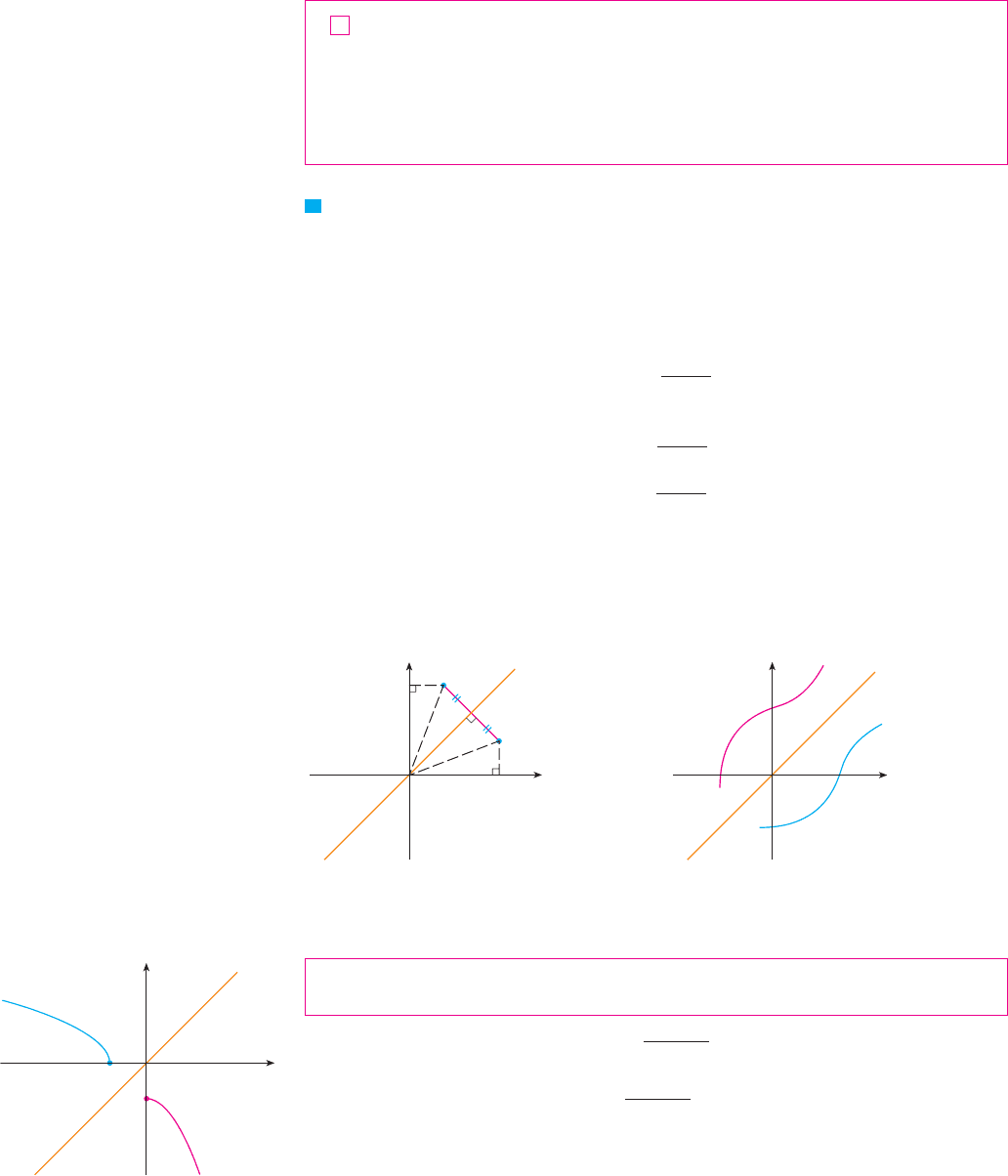
HOW TO FIND THE INVERSE FUNCTION OF A ONE-TO-ONE FUNCTION f
STEP 1 Write .
STEP 2 Solve this equation for in terms of (if possible).
STEP 3 To express as a function of x, interchange and .
The resulting equation is .
EXAMPLE 4 Find the inverse function of .
SOLUTION According to (5) we first write
Then we solve this equation for :
Finally, we interchange and :
Therefore the inverse function is . M
The principle of interchanging and to find the inverse function also gives us the
method for obtaining the graph of from the graph of . Since if and only if
, the point is on the graph of if and only if the point is on the
graph of . But we get the point from by reflecting about the line . (See
Figure 8.)
Therefore, as illustrated by Figure 9:
The graph of is obtained by reflecting the graph of about the line .
EXAMPLE 5 Sketch the graphs of and its inverse function using the
same coordinate axes.
SOLUTION First we sketch the curve (the top half of the parabola
, or ) and then we reflect about the line to get the
graph of . (See Figure 10.) As a check on our graph, notice that the expression for
is . So the graph of is the right half of the parabola
and this seems reasonable from Figure 10. My ! !x
2
! 1
f
!1
f
!1
!x" ! !x
2
! 1, x " 0f
!1
f
!1
y ! xx ! !y
2
! 1y
2
! !1 ! x
y !
s
!1 ! x
f !x" !
s
!1 ! x
y ! xff
!1
F I G U R E 8
F I G U R E 9
0
y
x
(b,a)
(a,b)
y=x
0
y
x
f –!
y=x
f
y ! x!a, b"!b, a"f
!1
!b, a"f!a, b"f
!1
!b" ! a
f !a" ! bff
!1
yx
f
!1
!x" !
s
3
x ! 2
y !
s
3
x ! 2
yx
x !
s
3
y ! 2
x
3
! y ! 2
x
y ! x
3
# 2
f !x" ! x
3
# 2
V
y ! f
!1
!x"
yxf
!1
yx
y ! f !x"
5
388
|| ||
CHAPTER 7 INVERSE FUNCTIONS
N In Example 4, notice how reverses the
effect of . The function is the rule “Cube,
then add 2”; is the rule “Subtract 2, then
take the cube root.”
f
!1
ff
f
!1
0
y=x
y=ƒ
(0,_1)
y=f –!(x)
(_1,0)
F I G U R E 1 0
y
x
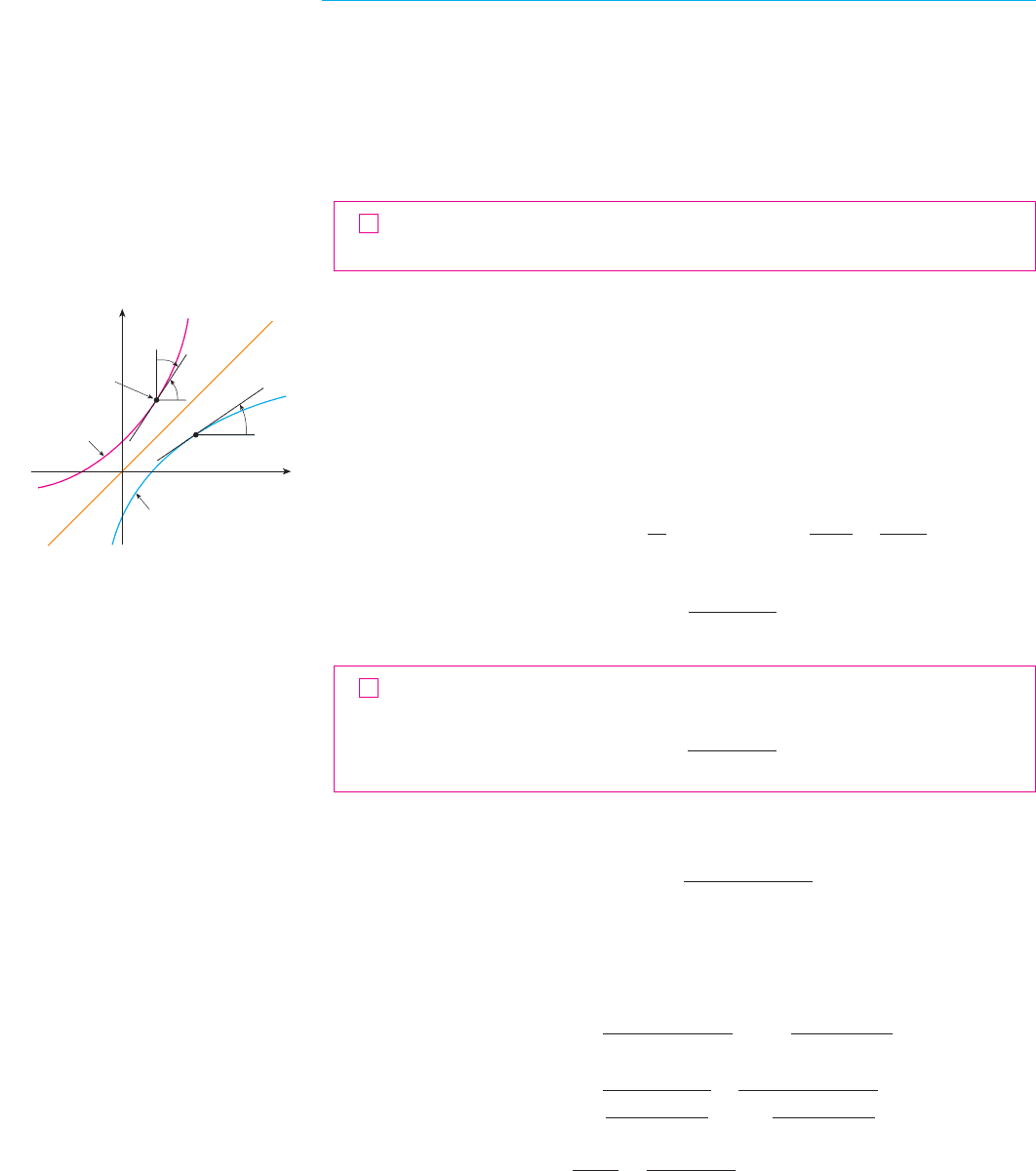
THE CALCULUS OF INVERSE FUNCTIONS
Now let’s look at inverse functions from the point of view of calculus. Suppose that is
both one-to-one and continuous. We think of a continuous function as one whose graph has
no break in it. (It consists of just one piece.) Since the graph of is obtained from the
graph of by reflecting about the line , the graph of has no break in it either (see
Figure 9). Thus we might expect that is also a continuous function.
This geometrical argument does not prove the following theorem but at least it makes
the theorem plausible. A proof can be found in Appendix F.
THEOREM If is a one-to-one continuous function defined on an interval, then
its inverse function is also continuous.
Now suppose that is a one-to-one differentiable function. Geometrically we can think
of a differentiable function as one whose graph has no corner or kink in it. We get the graph
of by reflecting the graph of about the line , so the graph of has no corner
or kink in it either. We therefore expect that is also differentiable (except where its tan-
gents are vertical). In fact, we can predict the value of the derivative of at a given point
by a geometric argument. In Figure 11 the graphs of and its inverse are shown. If
, then and is the slope of the tangent to the graph of at
, which is . Likewise, . From Figure 11 we see that ,
so
that is,
THEOREM If is a one-to-one differentiable function with inverse function
and , then the inverse function is differentiable at and
PROOF Write the definition of derivative as in Equation 3.1.5:
If , then . And if we let , then . Since is differ-
entiable, it is continuous, so is continuous by Theorem 6. Thus if , then
, that is, . Therefore
M !
1
f $!b"
!
1
f $! f
!1
!a""
! lim
y
l
b
1
f !y" ! f !b"
y ! b
!
1
lim
y
l
b
f !y" ! f !b"
y ! b
! f
!1
"$!a" ! lim
x
l
a
f
!1
!x" ! f
!1
!a"
x ! a
! lim
y
l
b
y ! b
f !y" ! f !b"
y l bf
!1
!x" l f
!1
!a"
x l af
!1
ff !y" ! xy ! f
!1
!x"f
!1
!a" ! bf !b" ! a
! f
!1
"$!a" ! lim
x
l
a
f
!1
!x" ! f
!1
!a"
x ! a
! f
!1
"$!a" !
1
f $! f
!1
!a""
af $! f
!1
!a"" " 0
f
!1
f
7
! f
!1
"$!a" !
1
f $! f
!1
!a""
! f
!1
"$!a" ! tan
%
! tan
&
&
2
!
'
'
! cot
'
!
1
tan
'
!
1
f $!b"
'
#
%
!
&
%2f $!b" ! tan
'
tan
%
!a, b"
f
!1
! f
!1
"$!a"f
!1
!a" ! bf !b" ! a
f
!1
f
f
!1
f
!1
f
!1
y ! xff
!1
f
f
!1
f
6
f
!1
f
!1
y ! xf
f
!1
f
SECTION 7.1 INVERSE FUNCTIONS
|| ||
389
N Note that because
is one-to-one.
f
x " a ? f ! y" " f !b"
x
0
y
graph of f
graph
of
(b,a)
(a, b)
y=x
¨
˙
¨
f –!
F I G U R E 1 1

Replacing by the general number in the formula of Theorem 7, we get
If we write , then , so Equation 8, when expressed in Leibniz notation,
becomes
If it is known in advance that is differentiable, then its derivative can be
computed more easily than in the proof of Theorem 7 by using implicit differentiation. If
, then . Differentiating the equation implicitly with respect to
, remembering that is a function of , and using the Chain Rule, we get
Therefore
EXAMPLE 6 Although the function , , is not one-to-one and therefore does
not have an inverse function, we can turn it into a one-to-one function by restricting its
domain. For instance, the function , , is one-to-one (by the Horizon-
tal Line Test) and has domain and range . (See Figure 12.) Thus has an
inverse function with domain and range .
Without computing a formula for we can still calculate . Since
, we have . Also . So by Theorem 7 we have
In this case it is easy to find explicitly. In fact, , . [In general,
we could use the method given by (5).] Then , so ,
which agrees with the preceding computation. The functions and are graphed in
Figure 13.
M
EXAMPLE 7 If , find .
SOLUTION Notice that is one-to-one because
and so is increasing. To use Theorem 7 we need to know and we can find it by
inspection:
Therefore M
! f
!1
"$!1" !
1
f $! f
!1
!1""
!
1
f $!0"
!
1
2 ! sin 0
!
1
2
f
!1
!1" ! 0?f !0" ! 1
f
!1
!1"f
f $!x" ! 2 ! sin x ( 0
f
! f
!1
"$!1"f !x" ! 2x # cos x
V
f
!1
f
! f
!1
"
$
!1" !
1
2
! f
!1
"
$
!x" ! 1%
(
2
s
x
)
0 ) x ) 4f
!1
!x" !
s
x
f
!1
! f
!1
"
$
!1" !
1
f $! f
!1
!1""
!
1
f $!1"
!
1
2
f $!x" ! 2xf
!1
!1" ! 1f !1" ! 1
! f
!1
"
$
!1"! f
!1
"
$
#0, 2$#0, 4$f
!1
f#0, 4$#0, 2$
0 ) x ) 2f !x" ! x
2
x ! !y ! x
2
dy
dx
!
1
f $!y"
!
1
dx
dy
f $!y"
dy
dx
! 1
xyx
f !y" ! xf !y" ! xy ! f
!1
!x"
f
!1
NOTE 2
dy
dx
!
1
dx
dy
f !y" ! xy ! f
!1
!x"
! f
!1
"$!x" !
1
f $! f
!1
!x""
8
xa
NOTE 1
390
|| ||
CHAPTER 7 INVERSE FUNCTIONS
F I G U R E 1 2
0
y
(a) y=≈, x ! R
x
2
0
y
(2,4)
(b) ƒ=≈, 0¯x¯2
0
y
x
(2,4)
(4,2)
(1,1)
f
F I G U R E 1 3
f –!
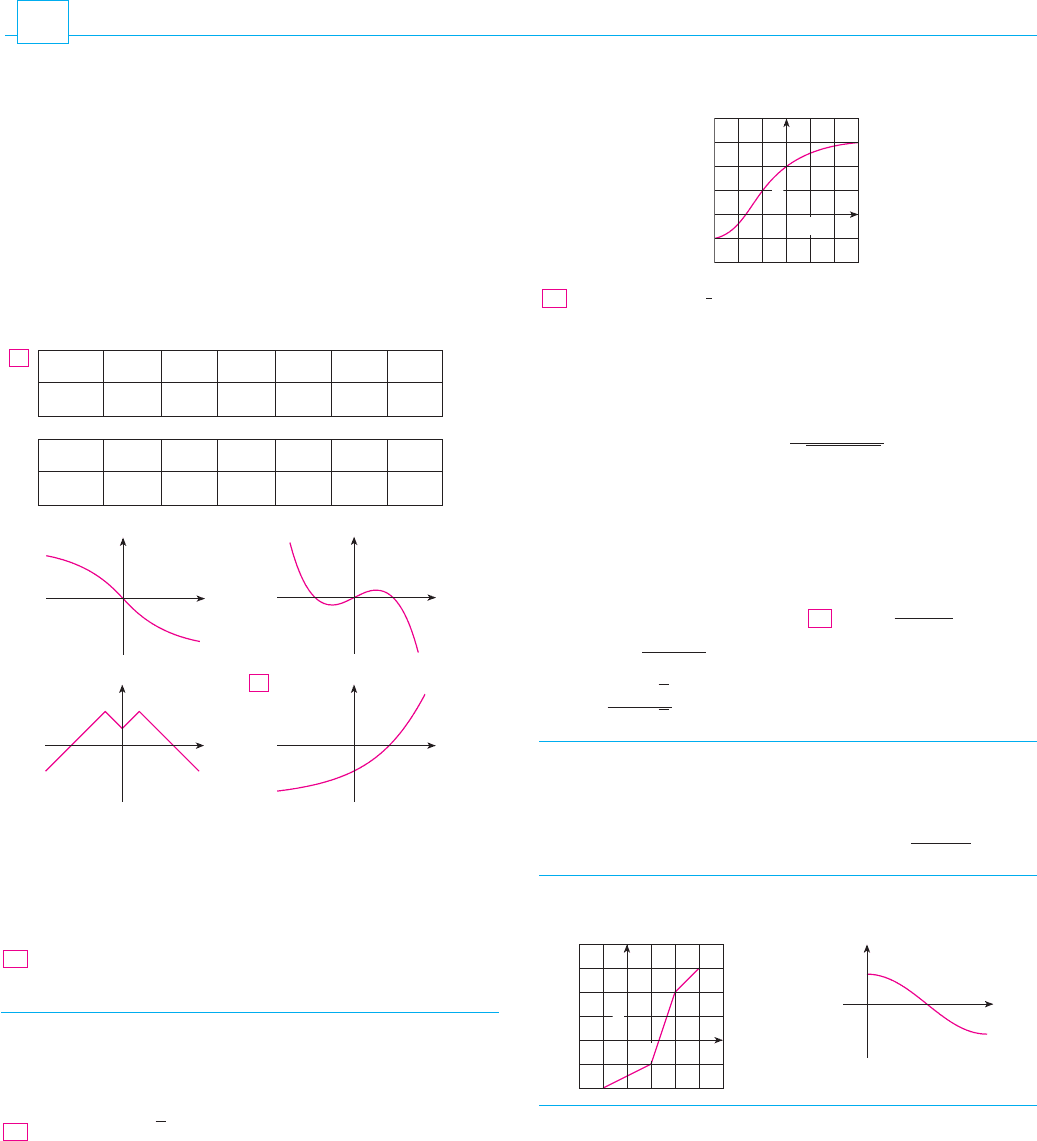
SECTION 7.1 INVERSE FUNCTIONS
|| ||
391
(c) What is the value of ?
(d) Estimate the value of .
The formula , where , expresses
the Celsius temperature C as a function of the Fahrenheit tem-
perature F. Find a formula for the inverse function and interpret
it. What is the domain of the inverse function?
22. In the theory of relativity, the mass of a particle with speed is
where is the rest mass of the particle and is the speed of
light in a vacuum. Find the inverse function of and explain
its meaning.
23–28 Find a formula for the inverse of the function.
23.
25. 26.
27. 28.
,
;
29–30 Find an explicit formula for and use it to graph ,
and the line on the same screen. To check your work, see
whether the graphs of and are reflections about this line.
29. , 30. ,
31–32 Use the given graph of to sketch the graph of .
31. 32.
33 –36
(a) Show that is one-to-one.
(b) Use Theorem 7 to find .
(c) Calculate and state the domain and range of .f
!1
f
!1
!x"
! f
!1
"$!a"
f
y
x
0
2
1
y
x
0
1
1
f
!1
f
x ( 0
f !x" !
s
x
2
# 2x
x " 0f !x" ! x
4
# 1
f
!1
f
y ! x
ff
!1
,f
!1
x " 2f !x " ! 2 x
2
! 8 xy !
1 !
s
x
1 #
s
x
y ! 2x
3
# 3f !x" !
s
10 ! 3x
f !x" !
4x ! 1
2x # 3
24.
f!x " ! 3 ! 2x
f
cm
0
m ! f !v" !
m
0
s
1 ! v
2
%c
2
v
F " !459.67C !
5
9
!F ! 32"
21.
y
x
0
1
1
f
!1
!0"
f
!1
!2"
1. (a) What is a one-to-one function?
(b) How can you tell from the graph of a function whether it is
one-to-one?
2. (a) Suppose is a one-to-one function with domain and
range . How is the inverse function defined? What is
the domain of ? What is the range of ?
(b) If you are given a formula for , how do you find a
formula for ?
(c) If you are given the graph of , how do you find the graph
of ?
3–16 A function is given by a table of values, a graph, a formula, or
a verbal description. Determine whether it is one-to-one.
4.
5. 6.
7.
9. 10.
11. 12.
13.
14.
,
is the height of a football t seconds after kickoff.
16. is your height at age t.
17. If is a one-to-one function such that , what
is ?
18. If , find .
If , find .
20. The graph of is given.
(a) Why is one-to-one?
(b) What are the domain and range of ?f
!1
f
f
h
!1
!6"h!x" ! x #
s
x
19.
f
!1
!1"f !x" ! x # cos x
f
!1
!9"
f !2" ! 9f
f !t"
f !t"
15.
0 ) x )
&
h!x" ! 1 # cos x
h!x" ! 1 # cos x
t!x" !
(
x
(
t!x" ! 1%x
f !x" ! 10 ! 3xf !x" ! x
2
! 2x
y
x
8.
x
y
y
x
x
y
3.
f
!1
f
f
!1
f
f
!1
f
!1
f
!1
B
Af
E X E R C I S E S
7.1
x 1 2 3 4 5 6
1.5 2.0 3.6 5.3 2.8 2.0f !x"
x 1 2 3 4 5 6
1 2 4 8 16 32f !x"
